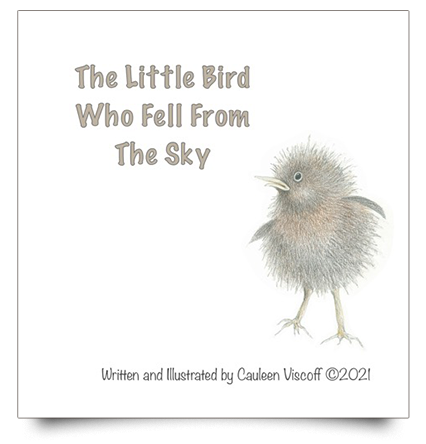I’d love to connect with you! Sign up for my monthly newsletter, "Garden Bliss & Blunder”
PLANTING ROSES
....other links:
PLANTING ROSES
(even if the soil is difficult)
Your roses will need 6 to 8 hours of sun every day...
Although there are some roses that will grow in the shade -
and in a hedge -see MY ROSE HEDGE
BEST TIME to PLANT ROSES?
That depends.
Some say Spring - after the soil warms up-but in our Zone 5 - it could be late May,but you'll still have a full growing season.
Others say plant them in the Fall - the soil will still be warm until almost the first frost and there is still enough time for new little roots to establish before the ground freezes.
I plant in both Spring because I get excited and in the Fall because many roses are on sale. If I water them well when I plant and mulch them, they survive winter.
I have planted in late November with snow falling because I had just moved and couldn't leave my beloved roses behind
I don't recommend it - but most of them lived - so it was worth the risk.
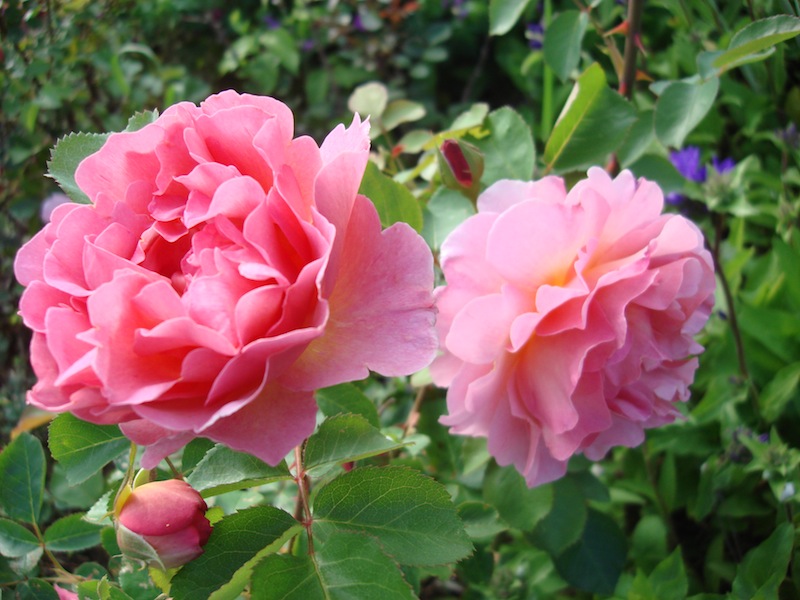 Gorgeous !
Gorgeous !BARE - ROOT ROSES
What is a "Bare-Root" Rose ?
These roses are dormant, meaning they are not actively growing.
and can be either "own root" or "grafted".
Some experts say planting them as bare-roots gives them a better chance - there is less transplant shock.
Bare root roses are easier and cheaper to ship so if you buy roses on-line, they often come in a cardboard box, roots in sawdust, all wrapped in plastic to keep the roots moist in transit.
Most big-box stores sell them in colourful plastic sleeves or bags surrounded by
sawdust or wood shavings.
If you buy them like this in the early spring, keep them moist - then soak them overnight before planting and plant them in the ground within two weeks after the last frost .
MY BARE - ROOT STORY
When I decided to plant roses, I knew nothing so I attended a lecture by a rose grower at our local garden show.
His photos of hundreds of roses were in glorious colour and of course when he handed out a catalogue, I was hooked.
I kept my list to just 10 of my favourites - that was hard. Ten "bushes" sounded like a lot, but he showed us dozens that would grow in our zone 5.
I got a real shock when I went to pick them up. There was no greenhouse, no row of roses in pots and worst of all, no blooms to see.
Yikes...Just a big old warehouse.
I handed in my money and my list and what I got in return, was a very large black plastic bag. Disappointing!
Inside that big bag were 10 dark brown, gnarled roots, each with a white plastic tag.
I had never seen 'BARE ROOT' Roses (no pot, no soil, no leaves, no buds- just bare roots).
Ugh.
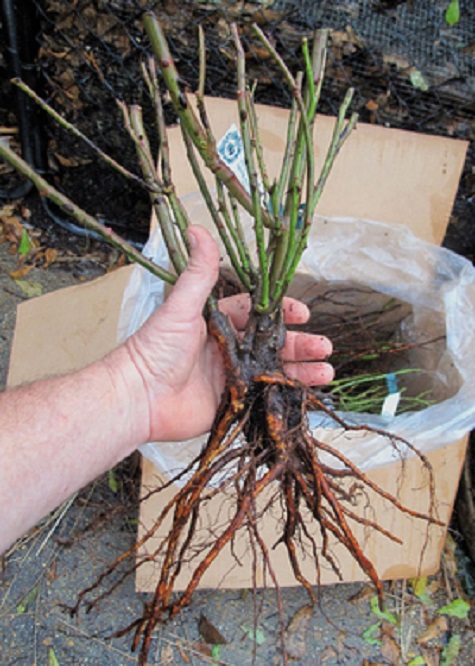 A Bare Root Rose
A Bare Root RosePhoto from David Austin Roses
Some roses are shipped in a box; some sold in plastic sleeves, mostly in big box stores; mine came in a black plastic bag.
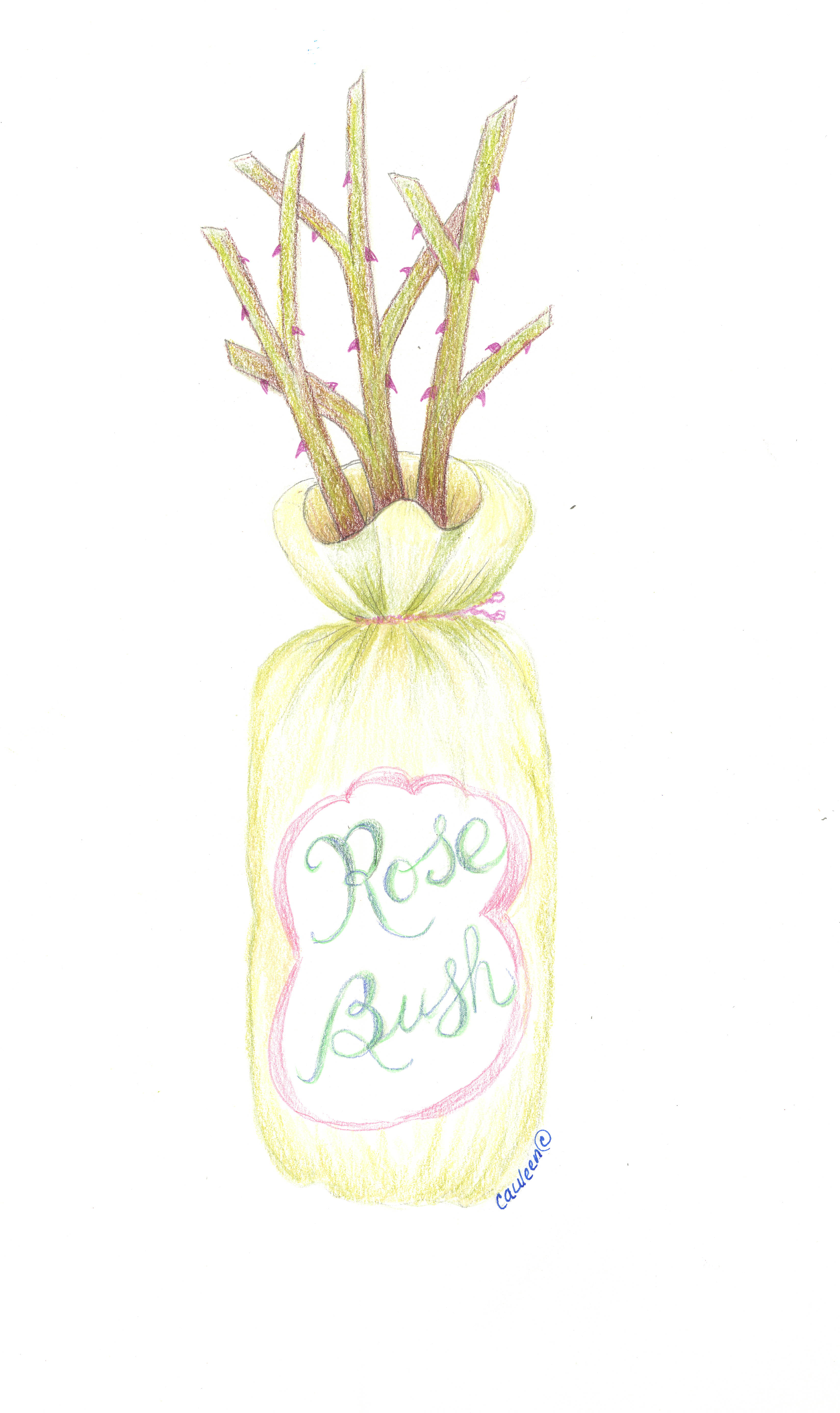 Bare-Root Bagged
Bare-Root BaggedTIP:
Buy the best rose you can afford.
Read the tag carefully to see its size when full grown.
Don't buy a rose for its smell or bloom for your border and discover it is a climber.
PLANTING ALL ROSES
SOAK YOUR ROSE FIRST:
Fill a pail of water and soak the roots over night to re-hydrate them and put the moisture back
- it also gives the roots a nudge or wake-up call.
DIGGING THE HOLE:
Oh...Please Don't prune them now.... except for a broken or torn root and then just trim its tip.
If a cane is broken, trim back to a new bud eye.
Make the hole twice as deep and twice as wide as the length of the roots.
If you have hard-packed clay soil, fill the hole with water and let it drain away before you plant.
Don't amend the soil unless your garden is in a new subdivision where they brought back topsoil (not yours) after the construction;
Use what it there and mix some compost with it.. otherwise, use only the soil you have.
Roses need to adapt to their new surroundings.
Place a small hill of soil in the centre of the hole and gently splay the roots over it.
Next, carefully put the soil back around the rose and gently pat it down to get rid of air pockets.
Be careful not to use your feet and tamp it down so tightly you'll smother it.
Add a layer of COMPOST round the rose, on top of the soil after you plant and then add a couple of inches of MULCH to keep the moisture in. Keep the mulch about 2-3 inches away from the stem(s)
FEED THE SOIL (with compost) ... NO need for added fertilizer... t he rose will get what it needs from the soil.
Rain and watering will let the nutrients from the compost seep into the soil...
After planting, Water deeply every couple of days... then once a week...for a few weeks unless very hot and dry.
If the leaves begin to droop, time to water... aim your watering can or hose at the base of the rose and count to 20 each time.
No point watering the leaves, it is the root that needs the water.
BARE - ROOT or OWN - ROOT...
PLANT THEM THE SAME WAY
(Own-root means it is NOT grafted)
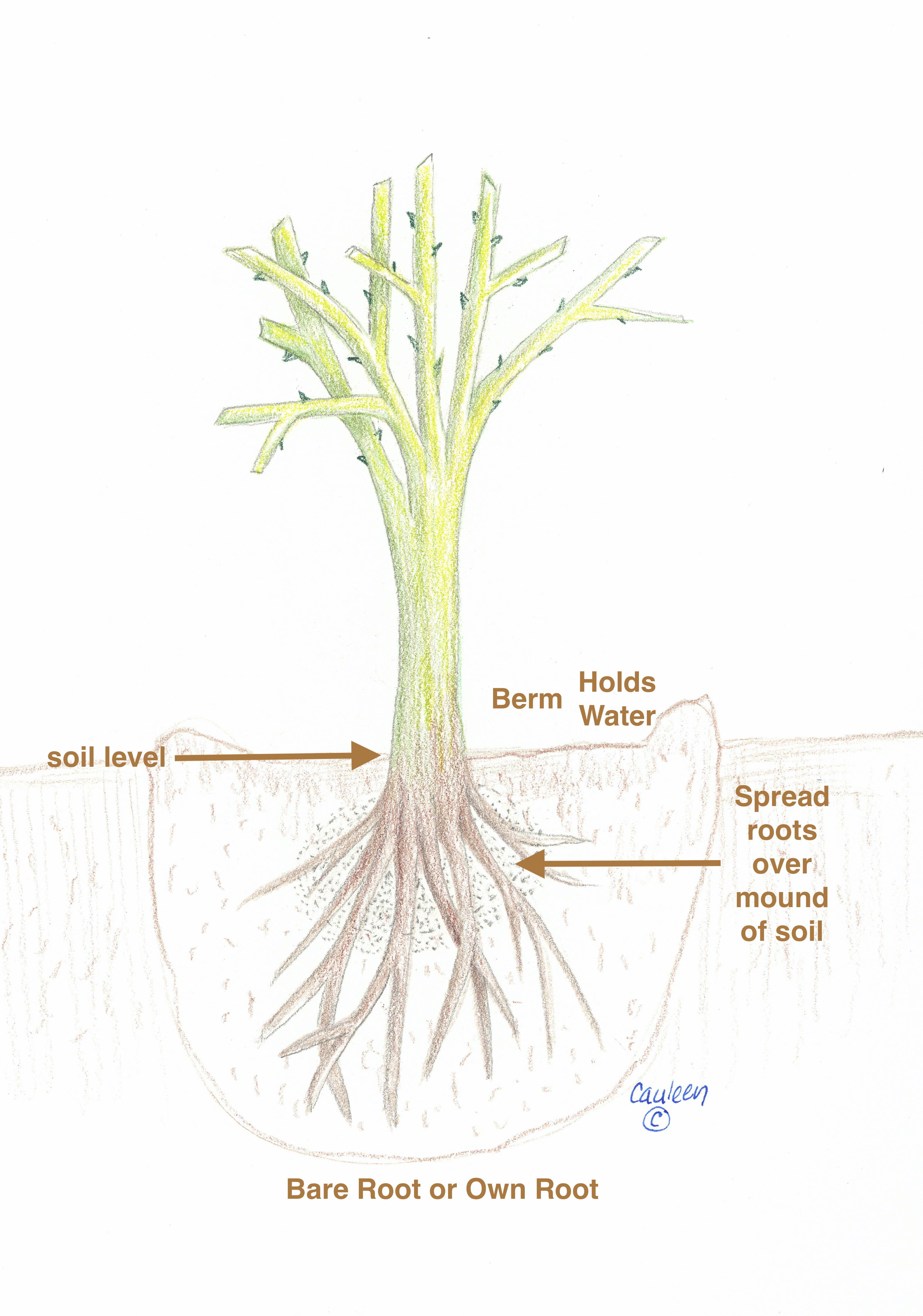 Bare Root or Own Root Rose
Bare Root or Own Root RoseCAUTION re: BONE MEAL
When I started planting roses, I read that bone meal was essential for getting roses started.
Then I found some research by Linda Chalker-Scott, PhD (Extension Horticulturist and Associate Professor, Puyallup Research and Extension Center, Washington State U.) who recently published a paper called-
"The Myth of Phosphate, Part II:
(MYTH) 'Roses Need Phosphate Fertilizer for Root and Flower Growth'.
She stated she couldn't find any research to support this any more than any other plant might and if you add phosphate to your roses when you plant them, you run the risk of decreasing the ability of the rose to use the beneficial mycorrhizal fungi to get the nutrients it needs on is own.
Instead, it creates the need to keep fertilizing the rose as it cannot get it for itself.
It's like having a cupboard full of chips next to a frig. full of veggies... which do we reach for?
See also www.theinformedgardener.com (look under Selected Publications and find "Horticultural Myths" and then find Bone Meal)
NEED to KNOW: TYPES OF COMPOST:
Although bagged composts can add a lot of nutrients to our soil, we can save resources, reduce our carbon footprint and make our own compost - or if you have no space to do this, pick it up from a local source ... no bagging or shipping and be sure it is PEAT-FREE
Peat is a non-renewable resource. Peatlands take centuries to regenerate - and we need not to be part of their destruction.
Coir - the hairy part of coconuts, is a great alternative; it does the same thing as peat and is more easily renewable.
PLANTING GRAFTED ROSES
A GRAFTED ROSE (also called a BUDDED ROSE) uses a hardy or strong root(stock) and adds - or grafts a less-hardy rose to it.
The graft itself is also a BUD-UNION.
It means a more delicate rose which might not survive in some zones, can live and bloom when grafted to another hardy root.
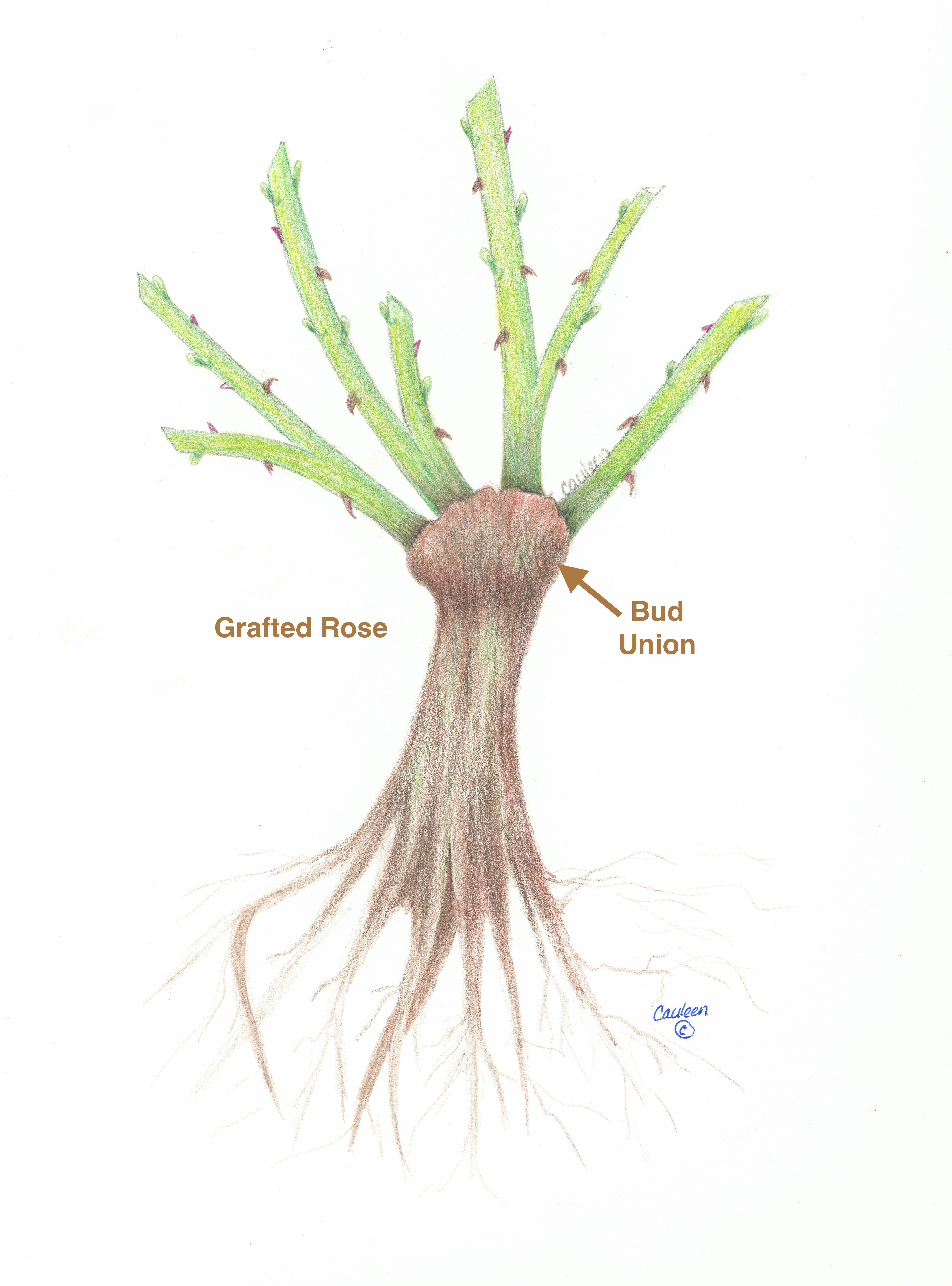 Grafted or Budded Rose
Grafted or Budded Rose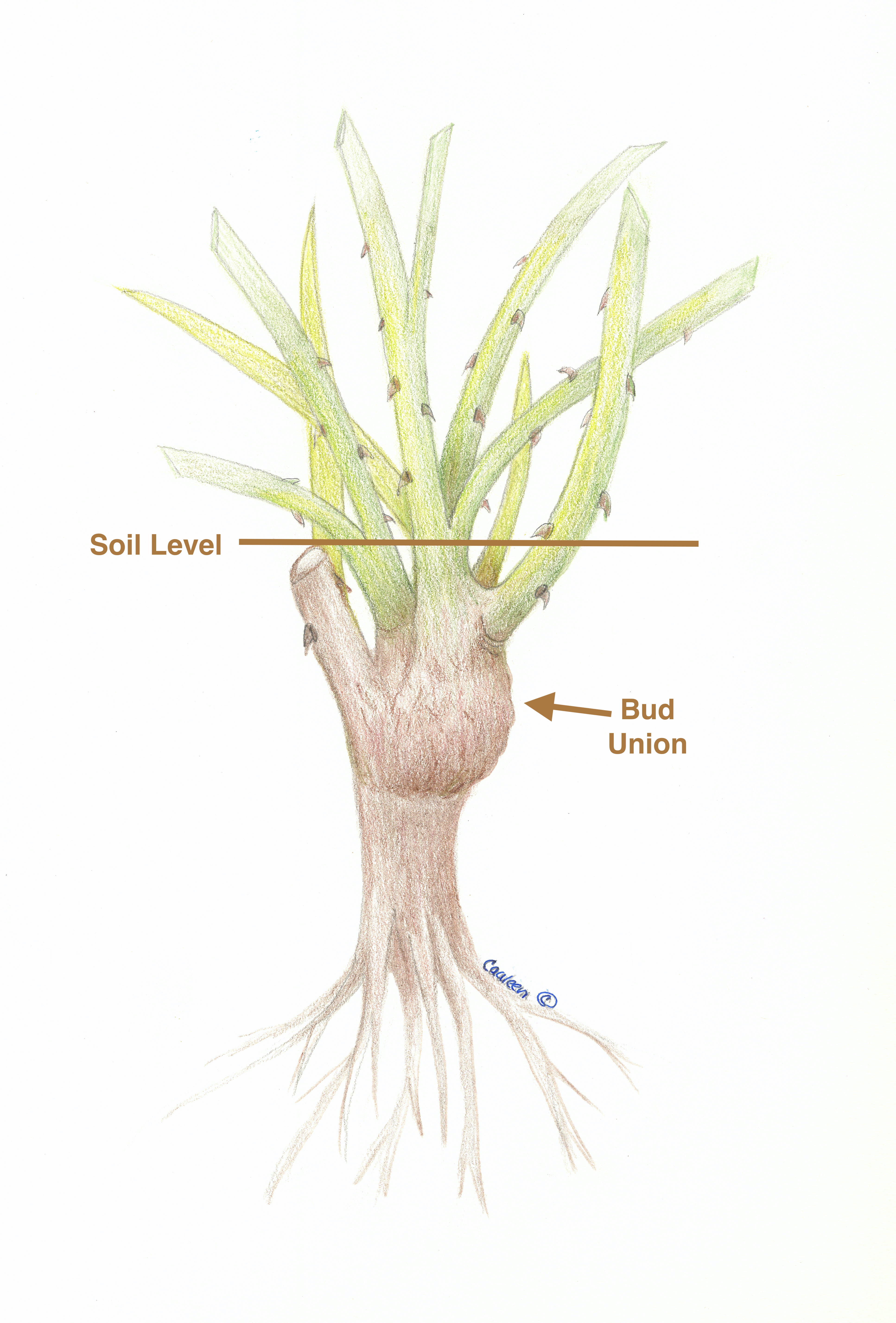 Grafted Rose Too
Grafted Rose TooSome Grafts are on the sides of the rootstock.
And, on some more "hybridized or advanced" roses,
the bud union(s) could also look like this.
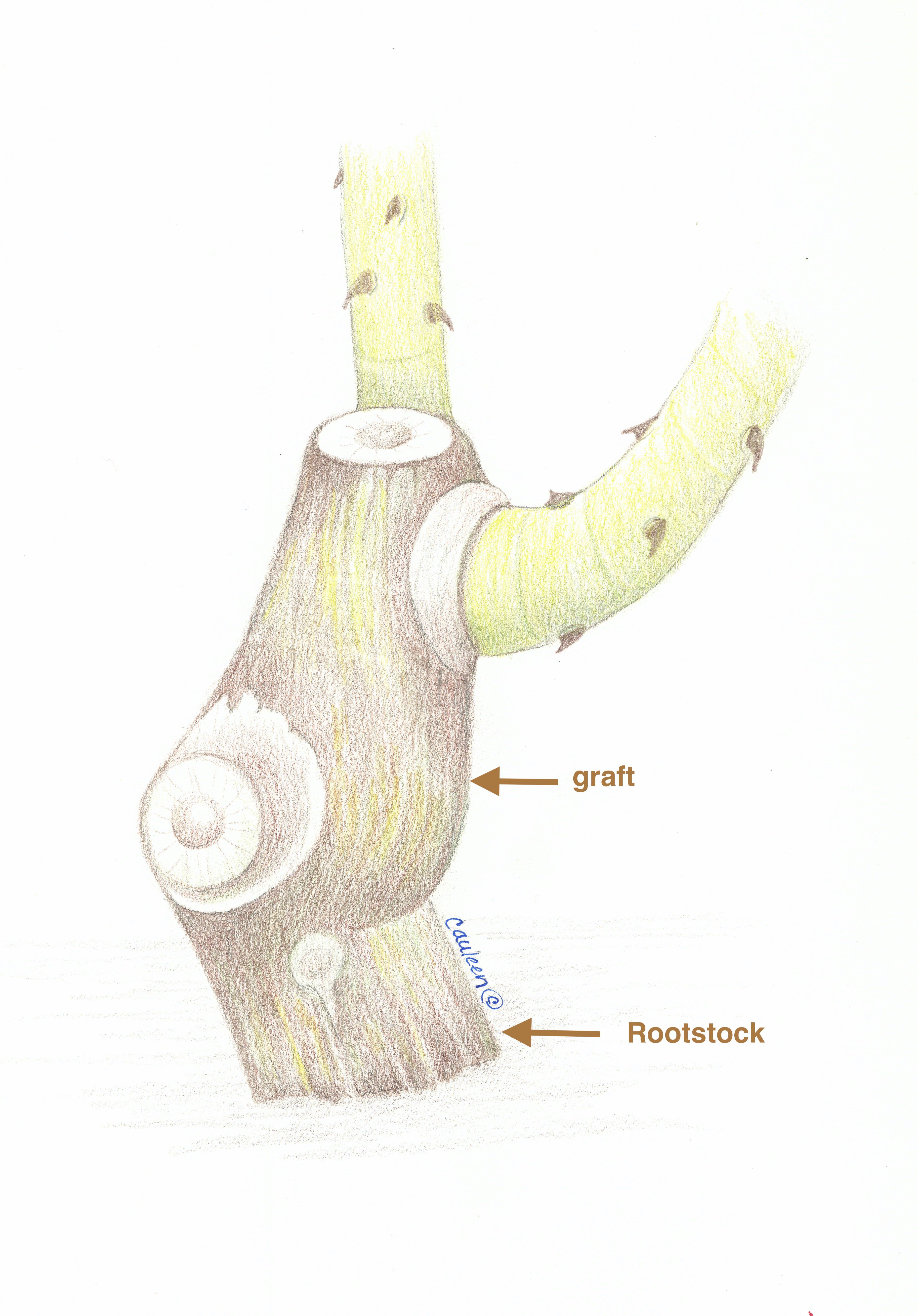 Grafted Rose Also
Grafted Rose AlsoPlant Rose Trees the same as an Own-root rose.
To complicate matters further, a rose tree has the graft(s) or bud-union(s) at the top of the rootstock's trunk or cane making the rose bush on top of the 'tree"... showy and stunning.
This makes overwintering rose trees more challenging
See more on Rose-Trees here.
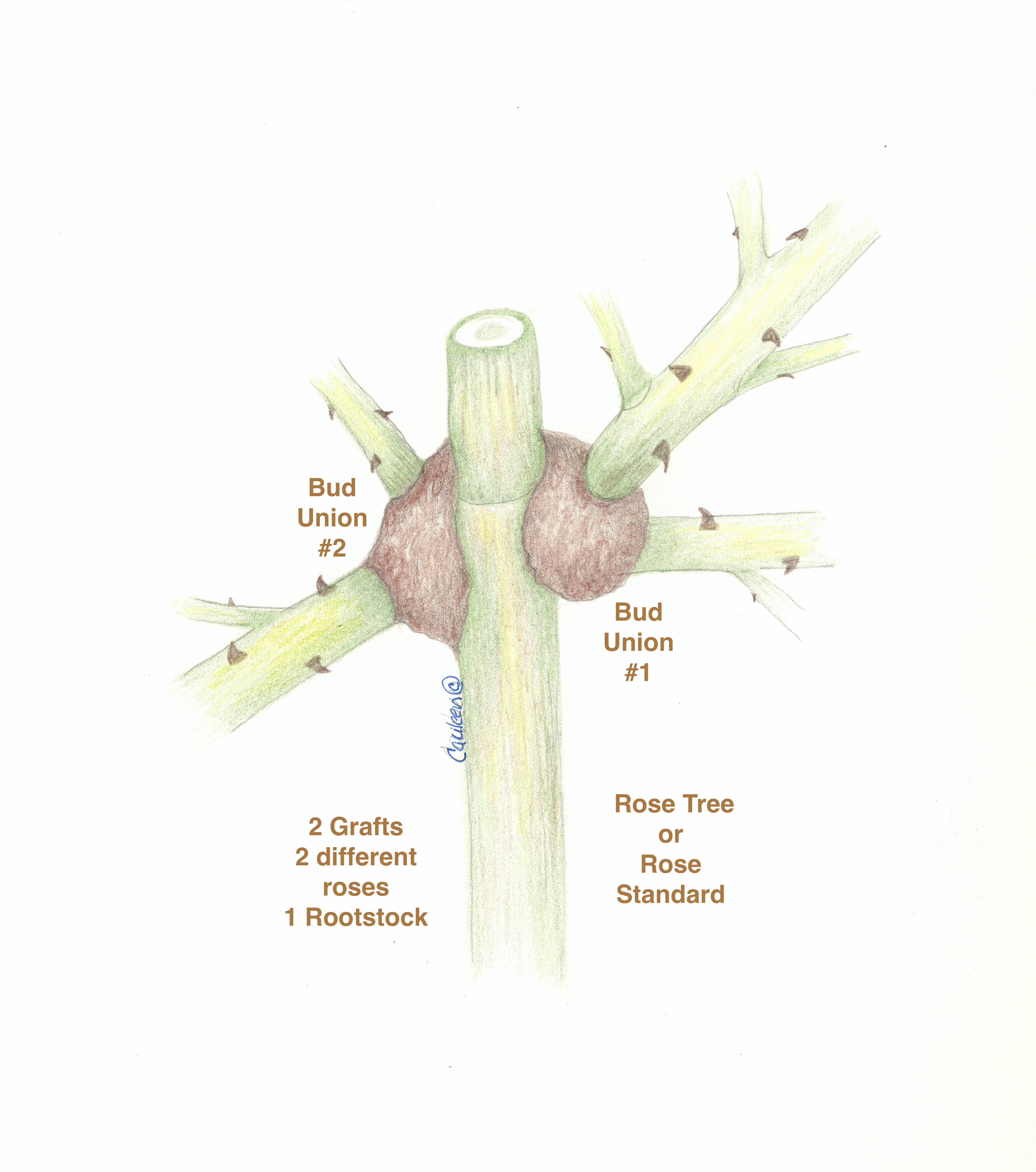 Rose Tree with two different grafts
Rose Tree with two different graftsPLANT THE BUD UNION DEEP...
Our Zone 5 can have some pretty brutal winters, so I bury the bud union - especially on grafted roses, at least 3 - 4 inches below the soil level.
WIND ROCK:
If you plant your rose with the bud union above the surface of the soil, winter winds can rock the tall canes and move the rose at the soil level, rocking it back and forth, creating a pocket or space around it, allowing in water, which can turn to ice and freeze the root.
CONTAINER or POTTED ROSES:
Bringing a potted rose home and leaving it sit for weeks before planting, is like inviting you to my home and making you sit on the doorstep while I am busy doing other things before letting you in… you'd most likely leave
… which is most likely what the rose would do if it could. Instead, it pouts and if you still ignore it, it checks out and dies. However, buying a rose in a pot gives you a few advantages;
- you can see how healthy the leaves are,
- how many buds or blooms
- you don't have to plant it right away.
Place the pot in different spots to see how it will look, how much space it needs and its height.
But keep it sheltered, out of the blazing sun and well-watered until you do plant it. Plastic pots heat up and get too hot especially when wet.... rather like cooking the roots.
Some roses will do well as patio roses, but if your zone is below 6 (cold and freezing winters) you will have to plant it in the garden in the late fall to save it.
PLANTING CONTAINER ROSES:
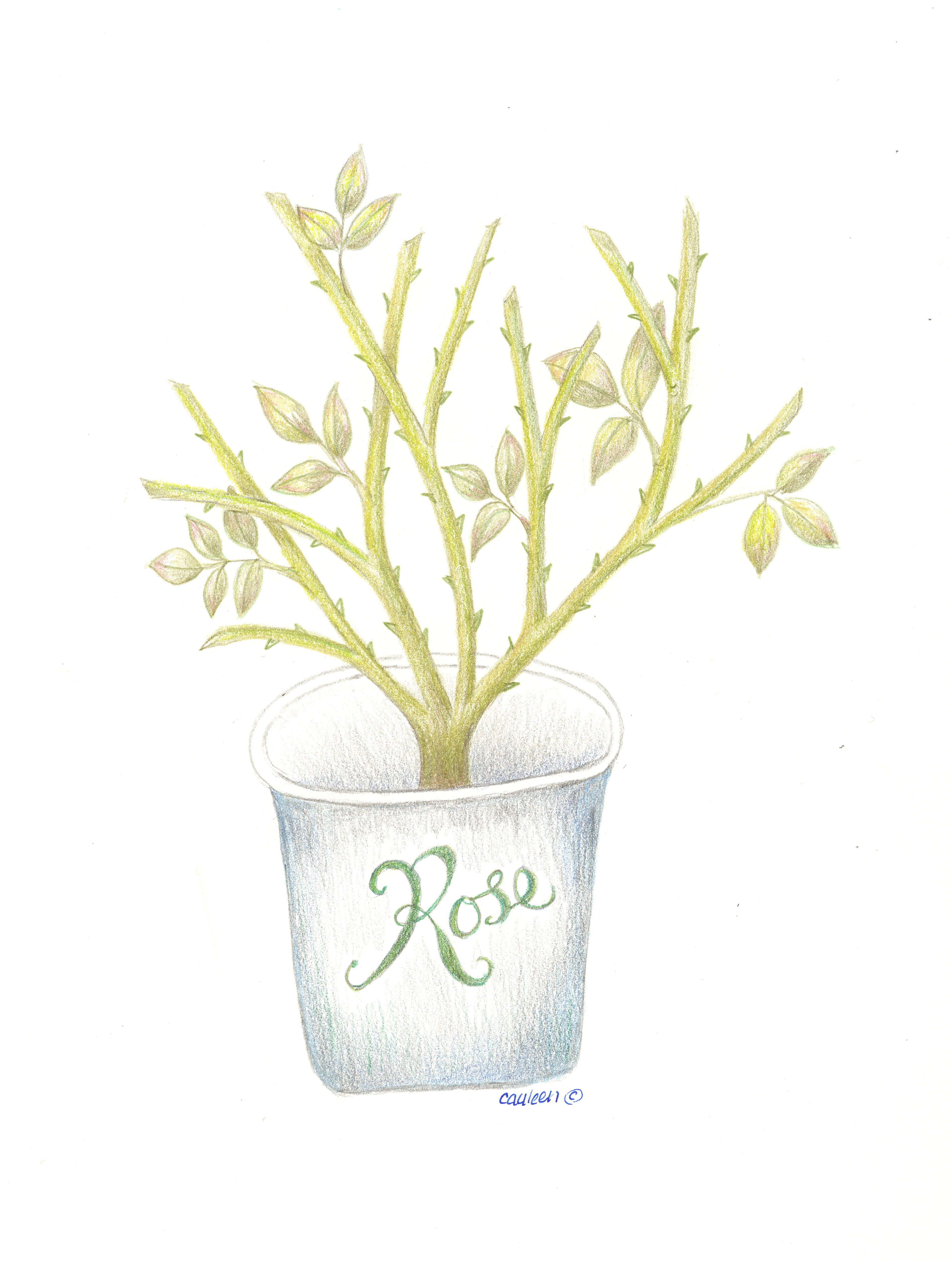 Potted or Container Rose
Potted or Container RosePlace the rose, pot and all in a bucket of water for at least an hour before you plant it.
Then before putting it in the hole, gently tease or fluff out the larger roots so they are not tangled around, inside the pot.
If the roots are circled or tangled, take a sharp knife and slit the sides all around and gently pull the roots apart.
Once planted, the rose will produce new little roots that will reach out into the new soil instead of staying in a round circle in the hole.
Fluff out the larger roots to give them space to breathe... don't worry about hurting it, you won't but do be careful of the small hair-like roots.
..... then plant it and water well.
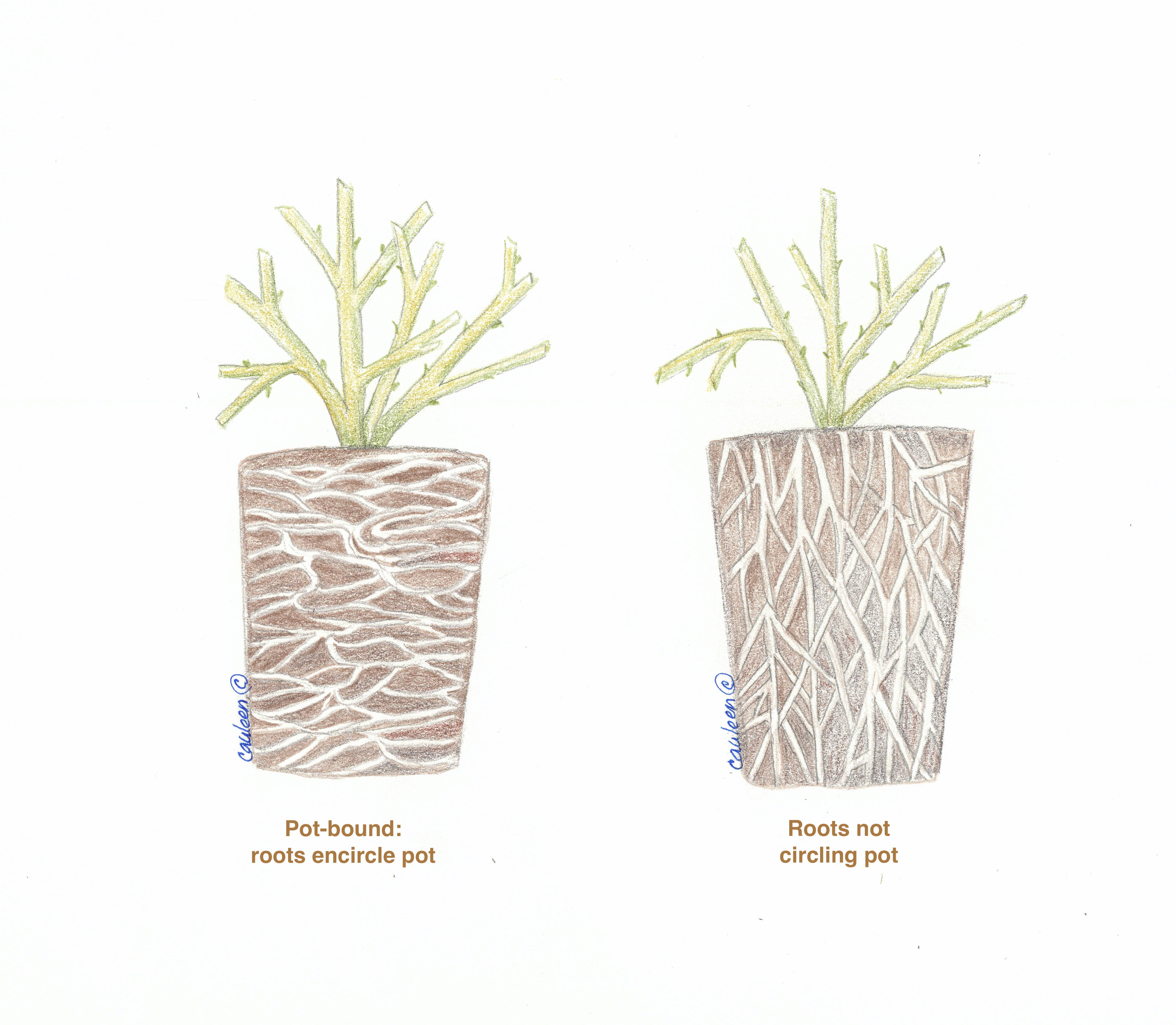 Potted Roses-roots
Potted Roses-rootsPOT BOUND means the rose could be in the pot for more than a season. The roots cannot grow downward as they would in the ground, so they keep encircling inside the pot, becoming tangled and matted.
The goal is to free up the roots so they are not suffocating as in left sketch.
Vertical cuts will free encircling roots and gently untangling others will give them chance to reach out into the soil to seek nutrients.
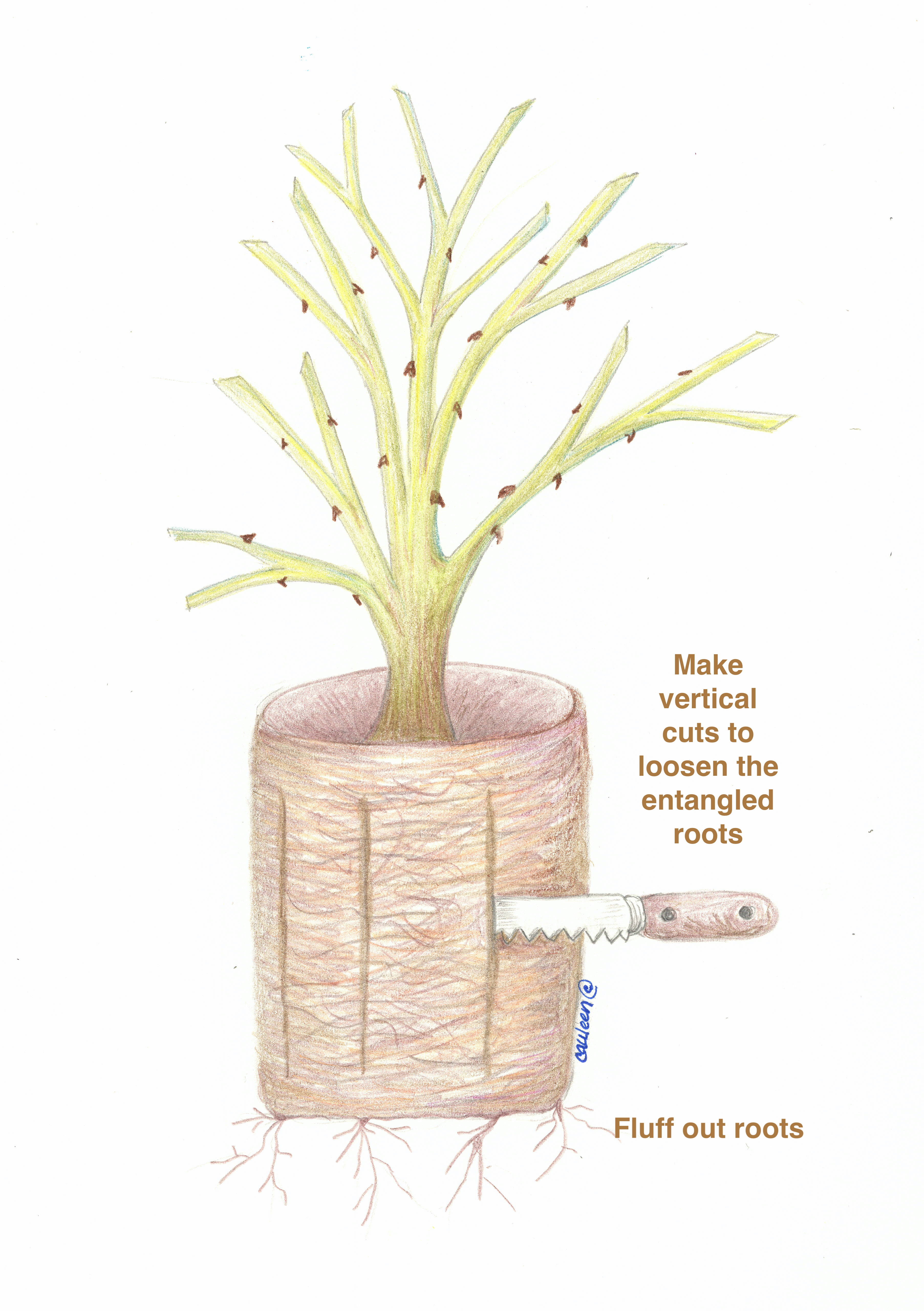 Potted Rose Vertical Cuts
Potted Rose Vertical Cuts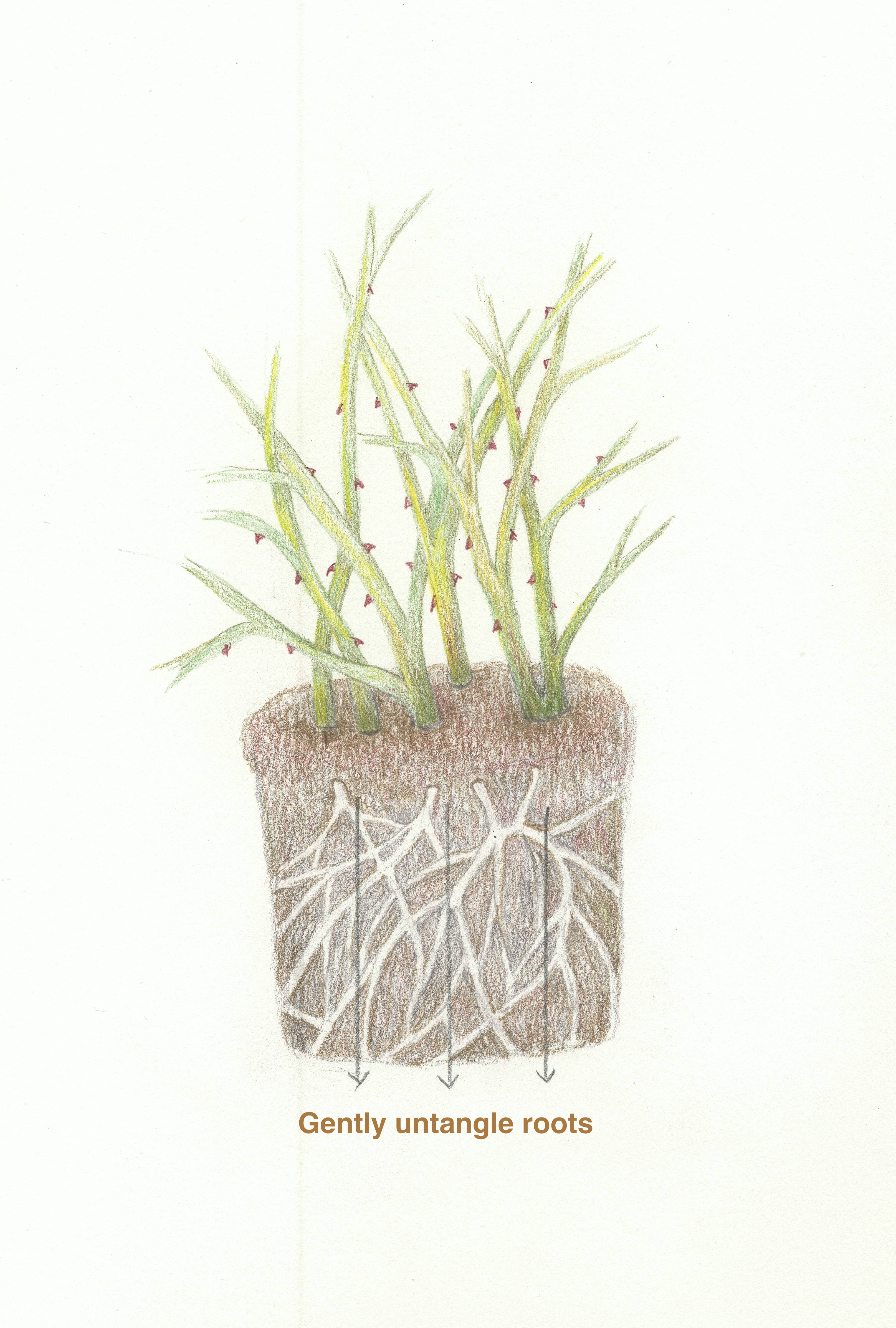 Potted Rose too
Potted Rose tooNo need for any cuts on this one.... gently loosen and untangle the roots before you plant.
Add COMPOST and MULCH
Put a 3 to 4 inch layer of compost around the rose - but not close enough to touch the stem...and then add a thick layer of natural mulch (at least 3 inches)
Don't use synthetic, plastic, stones or landscape fabric.
They will not keep weeds down and they will repel water and hold the heat.
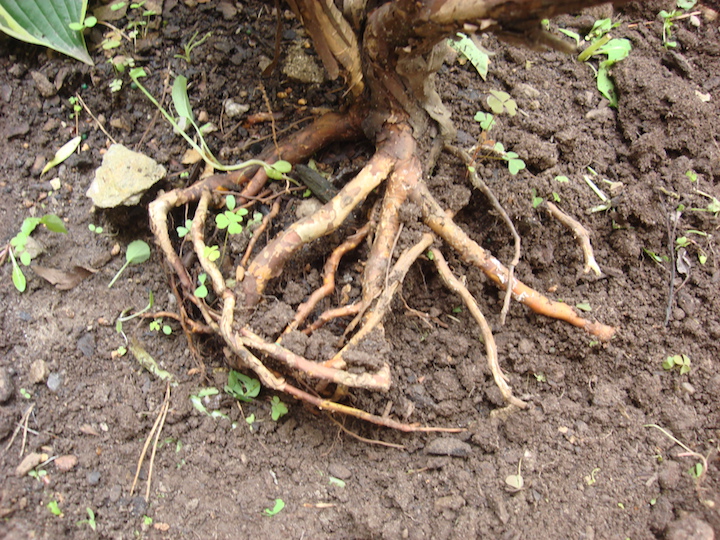 Encircled roots
Encircled rootsThis is what happens to roots left to encircle the hole if they have not been untangled when planted.... they keep growing in circles instead of reaching out into the soil for nutrients.
They eventually starve or suffocate and give up.
Do this to a pot-bound rose when you plant to prevent encircling roots.
MINIATURE ROSES:-CAUTION
Those gorgeous little masses of blooms are sold in most grocery or big box stores add a sweet bit of colour along the edge of a bed or in a patio pot or container.
But please READ THE TAG:
The tags are small and hard to read, but sometimes, the tags say the plant was treated with NEONICOTINOIDS - a pesticide.
If you are going to plant these mini roses in your garden, and the tag says the pesticide is used, you MUST wash all the soil from the roots and soak them overnight before planting them in your garden.
These little roses will often come back for a couple of years, but treat them as annuals and be thrilled when they reappear the following year.(zone 5)
Some other plants that are also treated with Neonics are potted Hydrangeas that are popular at Easter.
BE A CONSCIENTIOUS TAG READER
"You can complain because roses have thorns, or you can rejoice because thorns have roses".
Pablo Picasso
LAST BUT NOT LEAST....MAKE A MAP:
.... keep the tag and make a drawing or map so you will know what you planted and where.
You could even take a photo, print it and mark the names on the photo. I confess to not being good at this when I move a rose and alas, forget the following season where I put it...
Keep the tags in plastic sleeves meant for business cards.
One day, you may want to remember your rose's name:
Roses like to be called by name.
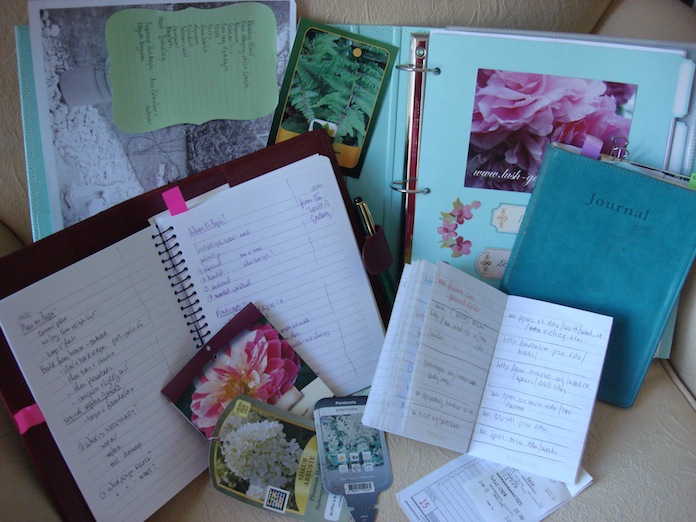 Garden Journals
Garden Journals“To be sure, an ordinary passerby would think that my rose looked just like you –the rose that belongs to me.
But in herself alone she's more important than all the hundreds of you other roses:
because it is she that I have watered;
because it is she that I have put under the glass globe;
because it is for her that I've killed the caterpillars (except the two or three we saved to become butterflies);
because it is she that I have listened to, when she grumbled,
or boasted, or even sometimes when she said nothing.
Because she is MY rose.”
Antoine de St. Exupery from ‘The Little Prince’
...And then, wait:
Give your rose a few days or even weeks to get settled before you look for buds..they spend their first energy putting down roots before they bloom...
If you have the courage and the rose you bought has blooms, cut them off so the energy will go to the roots...
Personally, I don't have that kind of courage..but you could then put them by your bed...
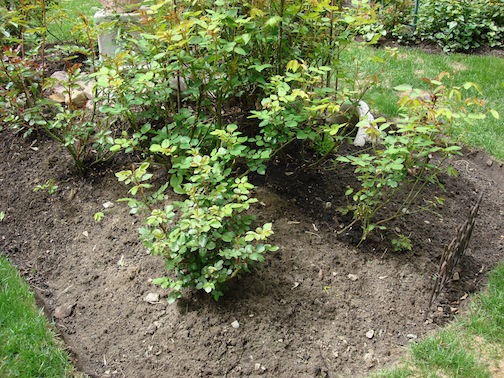 New Rose Bed
New Rose Bed.... before long, your roses will look like this.
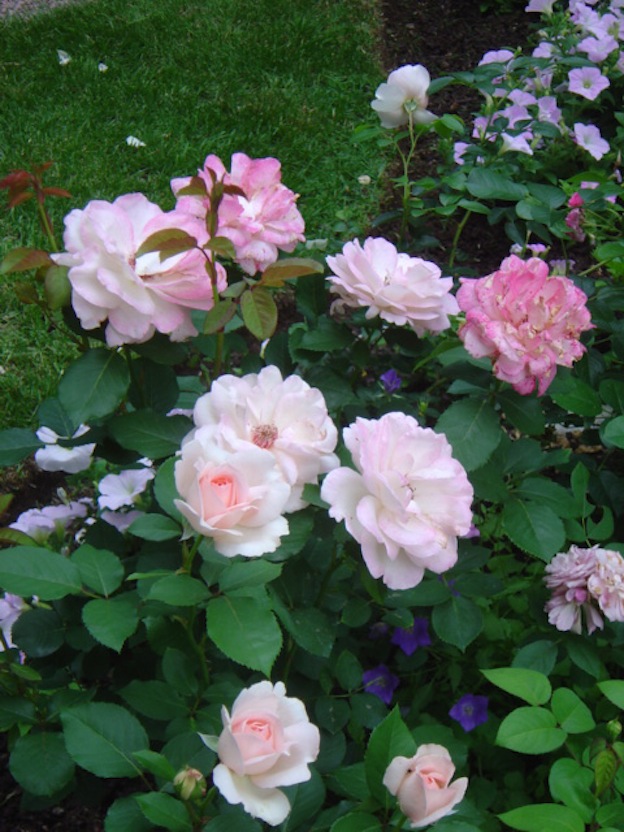 Roses in Bloom
Roses in BloomFERTILIZING ROSES:
Boy- so much controversy over doing it or not.
I used to do it once a week - a nice Sunday morning activity with an organic fertilizer for roses. Some say coffee grounds and tea leaves around your roses will make them better..
But the more research I do, and the more experimenting I do, the more I realize that instead of feeding my roses, I need to feed the soil.
Healthy soil grows healthy roots which grow healthy plants.
I was looking for quick fixes and then found many of my roses were not lasting more than a year or two.
So, for the past 3 years, we have gone 'cold turkey' and no longer fertilize any of my roses or other perennials.
Instead, we are making the soil more nutrient-rich with lots of compost, letting the soil work its magic with the mycorrhizal fungi to create its own nurients.
I still save my organic coffee grounds and mix them in with my compost (not because the soil needs them, but because I don't want to waste them and if I mix them with compost, they will blend into the nutrient mix.
I have to say, it was hard not to keep fertilizing - the first summer, it took longer for the roses to have as many blooms as the previous year. But we kept adding compost and mulch, and the second season, they were almost back to the way they were when I was adding that blue juice.
if you are still fertilizing - please stop in mid-August because the rose needs to get ready for winter and concentrate its energy on strengthening the roots - and blooms use a lot of that energy.
Add compost and mulch - spring and fall.
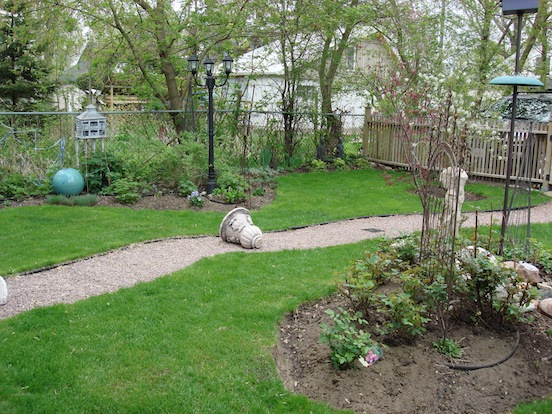 My first Rose bed
My first Rose bedThis is how my first rose bed looked a few weeks after I planted it.
But alas, my LACK of experience with
killed 8 out of my 10 roses.
I was devastated.
I didn’t plant them deep enough
and they froze at the bud union.
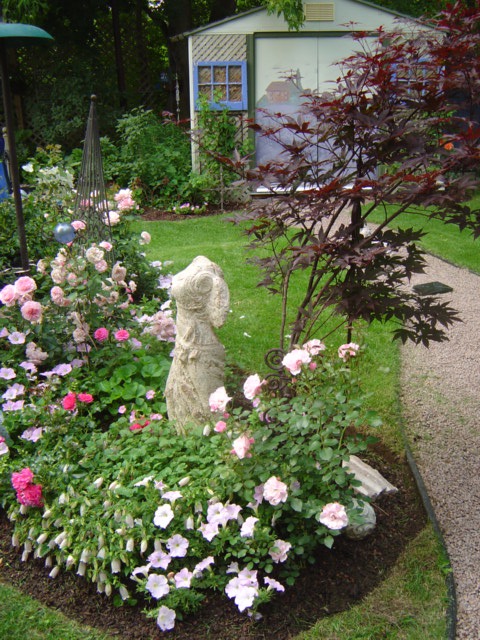 Rose Garden in Bloom
Rose Garden in BloomLet's Review THE BASICS....
BARE ROOT ROSES:
- shipped dormant; maybe in sawdust & plastic sleeve
- less shock when transplanted
- plant within 2 weeks after the last frost date
- soak in water overnight
- Put a small hill of soil in centre and splay the roots pat down to get rid of air pockets
OWN ROOT and GRAFTED ROSES
-the preparation is the same
- bury the bud union for both, 4 to 5 inches below soil level
POTTED ROSE:
- soak before planting
- trim dead, or broken branches
DIG YOUR HOLE:
- use the soil you removed from the holel.
- dig twice as wide and deep as pot or bare root
- deep enough to cover the bud union by 4 - 5 inches
- loosen soil on the edges of the hole
- if pot-bound - slice the sides to stimulate new growth
- gently tamp down soil.
- leave a small berm around rose to hold water
WATERING
- water every day the first week, then 3 times and then
deeply once a week until established
- water the roots - not the leaves
DON'T FERTILIZE:
- Add compost instead.
MULCH
- up to the rose, not touching the stem
MAKE A MAP:
- keep the tag and make a map.
Put all this in your GARDEN JOURNAL.
Take heart dear gardener; if I can do it, so can you.


